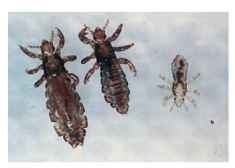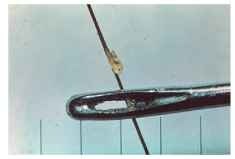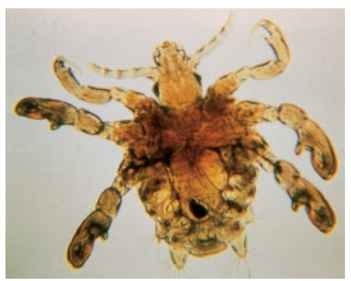Lice, Human
(Pediculus and Pthirus)
Lice are wingless, bloodsucking insects that belong to the order Phthiraptera. Although there are currently 4000 species of lice recognized, only 560 species suck blood and feed on mammals. Lice are very host specific; therefore human lice cannot be transmitted to or from other mammals. There are only three species of lice that infest humans: Pediculus humanus humanus, the body or “clothing” louse; Pediculus h. capitis, the head louse (Fig. 1) and Pthirus (or Phthirus) pubis, the crab or “pubic” louse (Fig. 3).
BIOLOGY
Lice, like all other insects, have six legs. They are hemimetabolic in development, meaning that they do not go through a complete

FIGURE 1 Female head louse (left), male (center), third in-star that just molted (right). Body lice and head lice are identical, except for size. The body louse is about 25% larger that the head louse. Females are larger than males and have an invaginated V and males have brown strips on their back.

FIGURE 2 Head louse egg (nit) which is about ready to hatch due to the “eye spot”. It is compared to a normal sewing needle for size comparison.

FIGURE 3 Crab louse. Pthirus pubis is broader than Pediculus spp., and resembles a crab.
metamorphosis like mosquitoes or fleas. There are three nymphal or “instar” stages that all look like a miniature adult. Within 7-12 days after eggs (nits) are laid, nymphs hatch, which will molt three times before becoming adults.
Within a few hours of hatching, the nymph must find a human blood meal or it will die of starvation and dehydration. At all stages, lice have a very tough, leathery cuticle capable of considerable expansion after feeding, usually taking in blood meals up to one-third of their own body weight every few hours. Regular feedings occur every 4—6 hours with head and crab lice, although body lice can survive for days without a blood meal. Several feedings occur between the shed of each chitinous exoskeleton or cuticle. The first, second, and third nymphal stages last 3—4 days each. It is not until the final molt that the sex can be determined. Females are usually 20% larger than males of the same species, as well as longer, wider, and rounder, with the posterior portion of the female terminating in an invaginated V-shape (Fig. 1). Gender identification is more difficult with Pthirus than with Pediculus.
Within 2 days of molting the female will feed several times, copulate, and begin laying an average of 3—6 eggs per day, with body lice laying more and crab lice laying fewer eggs. The female louse attaches the nits to hairs or fibers (in the case of body lice) by secreting a glue for which there is no solvent (Fig. 2). The life span of a louse from hatching through adult is 30—42 days.
HABITAT/EPIDEMIOLOGY Pediculus h. humanus
The body louse lives in clothing or bedding and travels to the host only to feed. The nits are laid on the clothing fibers, especially in the seams and collars. This is truly an infestation of individuals who are unable to wash themselves or their clothing.
Infestations with the body louse occur more commonly in individuals crowded together because of war, natural disaster, refugee status, or, in cooler climates, homelessness. They give all lice a “bad name” because people associate all lice with poor hygiene; however, this is the only human louse associated with lack of cleanliness.
Pediculus h. capitis
The head louse likes a clean healthy head and is found commonly on children 3—11 years of age. The nits are laid on the hair, usually close to the scalp for warmth. Head lice are primarily transmitted by head-to-head contact, which is more frequent in younger children; however, older siblings, parents, childcare workers, and teachers may also be infested. Sharing of brushes, combs, hats, helmets, and other headgear and hair accessories also can result in transmission.
Pthirus pubis
The crab louse (Fig. 3) prefers the pubic and perianal areas, but contrary to older literature, can also be found on the beard, mustache, scalp, axillae, eyebrows and eyelashes, or any hairy part of the body. Unlike head lice, which tend to be somewhat particular, crab lice are found in all levels of society, and are generally transmitted by sexual contact. HIV-positive and immunocompromised individuals are more difficult to treat. Adult crab lice can remain alive off of the host for at least 36 hours therefore, transmission by infested towels and bedding is more common than originally thought.
DISEASE TRANSMISSION
Pediculus h. humanus
Disease transmission primarily occurs as a result of contact with infested lice fecal pellets. The body louse is capable of transmitting the following diseases: epidemic typhus (caused by Rickettsia prow-azekii) , murine typhus (caused by R. typhii ) trench fever (caused by Bartonella quintana), and relapsing fever (caused by Borrelia recurrentis).
Pediculus h. capitis and Pthirus pubis
Head lice and crab lice are capable of transmitting group A Streptococcus pyogenes and Staphylococcus aureus. Neither head nor crab lice have been studied as transmitters of blood-borne diseases, but this is an area of current interest.
TREATMENT
Pediculus h. humanus
Clothing and bedding should be disinfested by washing in hot water and then drying in a hot cycle (65°C, 149°F). Permethrin or malathion dusting powders are effective in treatment for mass eradication of body lice infestations. For individual cases, people should be treated with prescription permethrin 5% topical cream or oral ivermectin.
Pediculus h. capitis
Over-the-counter lice treatments that contain 1% permethrin or natural pyrethrin products can be used, but resistance has been reported in the United States and other countries. Prescription malathion lotion and oral ivermectin are the most effective treatments. Lindane products should not be used because of toxicity and resistance.
Pthirus pubis
Although head lice products may be used on crab lice, the most effective treatment is 5% permethrin cream or oral ivermectin. All hairy areas of the body should be treated, including the scalp.
Phthiriasis palpebrarum
Since topical treatments should not be used around the eyes, crab lice of the eyelashes should be treated with petroleum jelly, which suffocates lice and eggs and lubricates the lashes, making nit removal easier.
